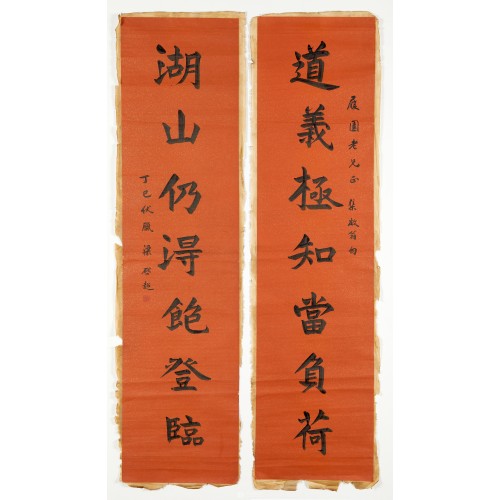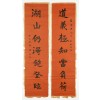본문
청말, 중화민국의 근대 사상가이자 정치가인 양계초(梁啓超)가 남송 제일의 시인인 방옹(放翁)의 시 구절을 쓴 작품입니다. 우측 낙구를 보면 이원 노형에게 드리는 작품임을 알 수 있습니다.
∎ 우측낙구 :
履園老兄正 集放翁句(이원노형정 집방옹구)
이원 노형께 방옹의 구절을 써서 드린다.
∎ 본문 ;
道義極知當負荷(도의극지당부하)
도와 의가 지극함을 알면 마땅히 떠맡을 것이고
湖山仍淂飽登臨(호산잉득포등임)
호수와 산은 여전히 고요하게 우뚝 솟아 있다.
∎ 좌측낙관 :
丁巳年 伏臘 梁啓超 (정사년,1917년 복랍 양계초)
∎ 참고 :
1. 梁啓超(양계초)
1873년 2월 23일 ~ 1929년 1월 19일 (향년 55세)
청말, 중화민국의 근대 사상가이자, 정치가, 언론가, 개혁가, 철학가, 문학가, 사학가, 교육가입니다. 1873년, 청나라 광둥성에서 태어났다. 秀才(수재)를 거쳐 15살에 鄕試(향시)에 합격, 거인(擧人)이 되었습니다. 향시에 합격한 이후 캉유웨이(康有爲)의 제자가 됩다. 1898년 캉유웨이와 함께 변법자강운동을 추진합니다. 당시 겨우 25세였습니다. 그러나 서태후 등 보수파의 쿠데타로 변법자강운동이 실패하자 일본으로 망명했습니다. 이후 1912년까지 14년 동안 중국에 돌아오지 못했습니다. 한편 1900년도 즈음에는 역시 일본에 망명 중이었던 쑨원(孫文)과 만났습니다. 신해혁명(청나라 멸망) 후에 40대로 인생의 절정기를 맞아 의회 운동의 당수, 사법 총장, 재무총장 등을 맡으며 잠시 위안스카이(袁世凱)와 연정하여 진보당을 이끌며 국회 내부의 정치를 이끌었습니다. 은퇴 후 베이징, 텐진 일대에서 저술, 교육활동을 하다가 1929년 베이징에서 사망했습니다. 1942년 중화민국 건국 및 호국전쟁에 참여한 공로를 인정하여 중화민국 정부가 표창을 내렸습니다. 주요 저서로 ≪新民說(신민설, 1902~1906)≫, ≪淸代學術槪論(청대 학술 개론, 1920)≫ 등이 있습니다.
2. 老兄(노형) : 그다지 가깝지 않은 사이에 예의를 갖추어 가리키거나 부르는 말
3. 丁巳年(정사년) : 1917년으로 양계초의 나이 44세 때.
4. 伏臘(복랍) : 三伏(삼복)과 臘日(납일). 여름 삼복에 지내는 제사인 伏祀(복사)와 겨울 납일에 지내는 제사인 臘享(납향)을 이름.
5. 履園(이원)
錢泳(전영)의 號(호) : 1759(청 건륭 24)년 ~ 1844(청 도광 24)년
중국 청대 후기의 서예가. 자는 立群(입군). 장쑤성 금귀 사람. 소식을 배웠다고 하나 모든 서체에 뛰어났으며, 특히 예서가 특징적이었습니다. 저서 ≪이원총화≫가 있습니다.
6. 放翁(방옹)
陸游(육유)의 號(호) : 1125 ~ 1210. 字(자)는 務觀(무관). 중국 남송의 第一(제일)의 시인으로, 나라의 상황을 慨歎(개탄)한 시나 전원의 한적한 생활을 주제로 한 시가 많다. 글씨도 뛰어났습니다. 詩集(시집) ≪劍南詩稿(검남시고)≫와 紀行文(기행문) ≪入蜀記(입촉기)≫ 등이 있습니다.
━━━━━
清末、近代思想家兼政治家梁启超所写的南宋第一大诗人陆游的诗句。由右侧落款可见,此作品是赠予履园老兄之作。
∎ 右侧落款 :
履園老兄正 集放翁句
∎ 正文 ;
道義極知當負荷
湖山仍淂飽登臨
∎ 左侧落款 :
丁巳年 伏臘 梁啓超
∎ 参考 :
1. 梁启超
(1873年2月23日 - 1929年1月19日,享年55岁)
清末及中华民国的近代思想家、政治家、新闻工作者、改革家、哲学家、文学家、史学家、教育家。1873年生于清朝广东省。通过秀才考试后,15岁时考中乡试,成为举人。考中乡试后,成为康有为的弟子。1898年,他与康有为共同推动戊戌变法,当时年仅25岁。然而,由于慈禧太后等保守派发动政变,戊戌变法失败,他被迫流亡日本。此后长达14年(至1912年)未能返回中国。1900年前后,他在日本流亡期间结识了孙文(孙中山)。辛亥革命(清朝灭亡)后,进入人生巅峰期,担任议会运动的领袖、司法总长、财政总长等职务,并一度与袁世凯联合,领导进步党,主导国会内政。晚年,他退隐后在北京、天津一带从事著述与教育活动,1929年在北京去世。1942年,中华民国政府表彰其对建国及护国战争的贡献。主要著作包括:《新民说》(1902-1906)、《清代学术概论》(1920)等。
2. 老兄:对关系不太亲近的人,表示礼貌的称呼或指称。
3. 丁巳年:指1917年,当时梁启超44岁。
4. 伏腊:夏季伏日和冬季腊日的祭祀。
5. 履园(钱泳的号)
钱泳(1759年 - 1844年),清朝晚期书法家,字立群,江苏金匮(今无锡)人。他以苏轼为宗,但擅长各种书体,尤以隶书最具特色。著有《履园丛话》。
6. 放翁(陆游的号)
陆游(1125年 - 1210年),字务观,南宋第一大诗人。其诗歌主题多为感叹国家时局,或描绘田园闲适生活。他还擅长书法。代表作包括诗集《剑南诗稿》及游记《入蜀记》等。
━━━━━
This is a work by Liang Qichao (梁启超), a modern thinker and politician from the late Qing Dynasty and the Republic of China. The piece features a verse from Fang Weng (放翁), the greatest poet of the Southern Song Dynasty. The inscription on the right side indicates that the work was dedicated to Li Yuan.
∎ Right-Side Inscription:
"To Elder Brother Lüyuan, presenting a verse from Fang Weng."
履園老兄正 集放翁句
∎ Main Text:
"When one truly understands the essence of morality and righteousness, one must shoulder the responsibility."
道義極知當負荷
"The lakes and mountains remain serene and towering as ever."
湖山仍淂飽登臨
∎ Left-Side Signature:
"Dingsi Year (1917), during Fula, Liang Qichao."
丁巳年 伏臘 梁啓超
∎ Reference:
1. Liang Qichao (1873–1929)
Born on February 23, 1873, in Guangdong Province, Qing China, and passed away on January 19, 1929, at the age of 55.
A prominent modern Chinese thinker, politician, journalist, reformist, philosopher, writer, historian, and educator.
Passed the Xiucai (秀才) exam and, at the age of 15, passed the Xiangshi (鄕試) to become a Juren (擧人).
Became a disciple of Kang Youwei (康有爲) after passing the provincial exam. In 1898, at the age of 25, he and Kang Youwei led the Hundred Days’ Reform movement. However, after the conservative coup led by Empress Dowager Cixi, the reform failed, and Liang fled to Japan, remaining in exile for 14 years until 1912.
Around 1900, while in exile in Japan, he met Sun Yat-sen (孫文).
After the Xinhai Revolution (which led to the fall of the Qing Dynasty), he entered his political prime in his 40s, serving as the leader of the parliamentary movement, Chief Justice, and Minister of Finance. He briefly allied with Yuan Shikai (袁世凱), leading the Progressive Party and playing a key role in parliamentary politics.
After retiring, he devoted himself to writing and education in Beijing and Tianjin until his death in 1929.
In 1942, the Republic of China government officially recognized his contributions to the country's founding and national defense.
Major works include "New Citizen" (新民說, 1902–1906) and "An Overview of Qing Dynasty Scholarship" (清代學術槪論, 1920).
2. 老兄 (Lao Xiong / Elder Brother): A respectful term used to address someone who is not particularly close but requires polite acknowledgment.
3. 丁巳年 (Dingsi Year):
Refers to the year 1917, when Liang Qichao was 44 years old.
4. 伏臘 (Fula): A term referring to Sanfu (三伏, the three hottest days of summer) and Lapri (臘日, a sacrificial day in winter).
It includes Fushi (伏祀, summer sacrifices during Sanfu) and Laxiang (臘享, winter sacrifices during Lapri).
5. 履園 (Luyuan)
Hao (Pseudonym) of Qian Yong (錢泳)
Born: 1759 (24th year of the Qianlong reign, Qing Dynasty)
Died: 1844 (24th year of the Daoguang reign, Qing Dynasty)
A late Qing Dynasty calligrapher from Jiangsu's Jinkui region. His courtesy name was Li Qun (立群).
Though he was influenced by Su Shi (蘇軾), he excelled in all styles of calligraphy, with clerical script (隷書, Lishu) being particularly distinctive.
Notable Work: Lüyuan Zonghua (履園叢話)
6. 放翁 (Fang Weng)
Hao (Pseudonym) of Lu You (陸游)
Born: 1125
Died: 1210
Courtesy name: Wu Guan (務觀)
The greatest poet of the Southern Song Dynasty, known for poetry expressing lamentation over national affairs and pastoral solitude.
Also a skilled calligrapher.
Notable Works:
Jian Nan Shi Gao (劍南詩稿, "Poetic Drafts of Southwest China")
Ru Shu Ji (入蜀記, "Diary of Entering Shu")

